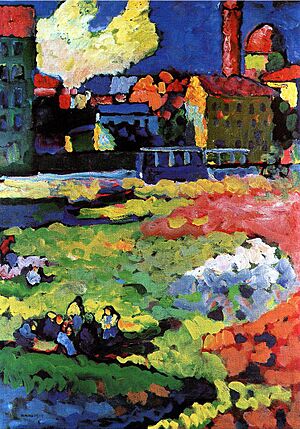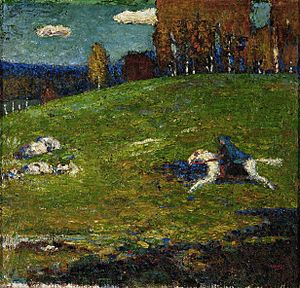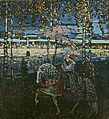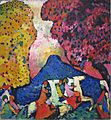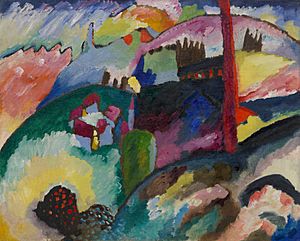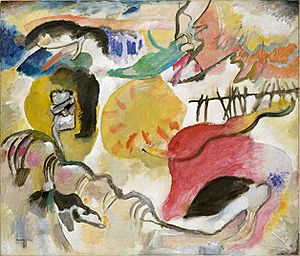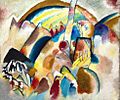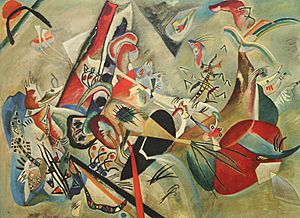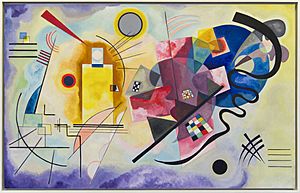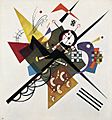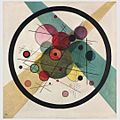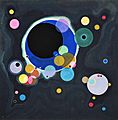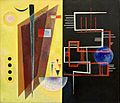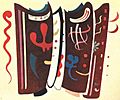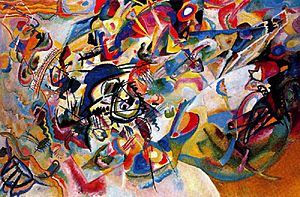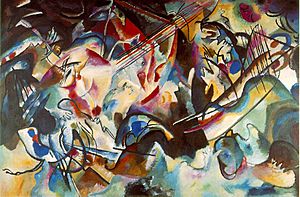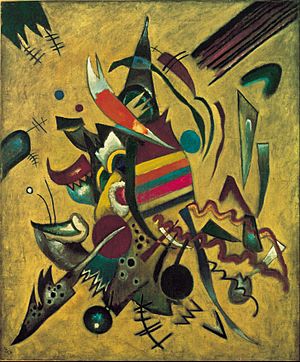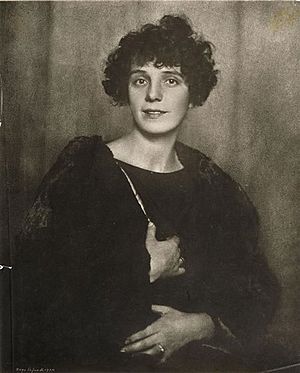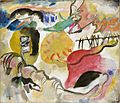Wassily Kandinsky facts for kids
Quick facts for kids
Wassily Kandinsky
|
|
|---|---|
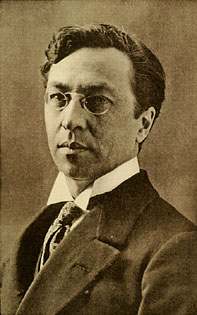
Kandinsky, c. 1913 or earlier
|
|
| Born |
Wassily Wassilyevich Kandinsky
16 December [O.S. 4 December] 1866 |
| Died | 13 December 1944 (aged 77) Neuilly-sur-Seine, France
|
| Nationality | Russian, later French |
| Education | Academy of Fine Arts, Munich |
| Known for | Painting |
|
Notable work
|
On White II, Der Blaue Reiter |
| Movement | Expressionism; abstract art |
Wassily Kandinsky (born December 16, 1866 – died December 13, 1944) was a famous Russian painter and art thinker. Many people see him as one of the first artists to create abstract art. Abstract art does not show things that look real. Instead, it uses shapes, colors, and lines to express feelings or ideas.
Kandinsky was born in Moscow, Russia. He spent his childhood in Odessa, where he studied art. Later, he went to the University of Moscow to study law and economics. Even though he was good at law, Kandinsky started studying painting when he was 30 years old.
In 1896, Kandinsky moved to Munich, Germany, to study art more deeply. He returned to Russia in 1914 when World War I began. After the Russian Revolution, he helped set up art museums. But his ideas about art were different from the new government's. So, he moved back to Germany in 1920. There, he taught at a famous art school called the Bauhaus. The Nazis closed the school in 1933. Kandinsky then moved to France, where he lived for the rest of his life. He became a French citizen in 1939 and made some of his most important art there. He passed away in 1944.
Contents
Kandinsky's Early Life and Art Journey
Kandinsky was born in Moscow. His father was a tea merchant. Kandinsky learned many things in school, including law and economics. He remembered being very interested in colors as a child. This interest in how colors make us feel stayed with him his whole life.
In 1889, when he was 25, Kandinsky joined a research trip to the Vologda region in Russia. He saw houses and churches decorated with bright, shimmering colors. He felt like he was stepping into a painting. This experience, and seeing the region's folk art, influenced his early work. He especially liked how they used bright colors on dark backgrounds.
A few years later, he compared painting to making music. He wrote, "Color is the keyboard, the eyes are the hammers, the soul is the piano with many strings. The artist is the hand which plays, touching one key or another, to cause vibrations in the soul." This idea of art and music being connected was very important to him.
Kandinsky was also the uncle of a famous French philosopher named Alexandre Kojève.
How Kandinsky's Art Changed
Kandinsky's journey to abstract art took a long time. It came from deep thinking about his art experiences. He called his focus on inner beauty and spiritual feelings "inner necessity." This idea was key to his art. Some art historians say he became interested in abstract art by accident. One day, he saw one of his own paintings hanging upside down. He looked at it for a while before realizing it was his own work. This made him think about how powerful art could be without showing real objects.
In 1896, Kandinsky decided to stop his law career. He joined the Academy of Fine Arts, Munich. He was not accepted right away, so he started learning art on his own. That same year, he saw paintings by Claude Monet. He was especially impressed by Monet's Haystacks. Kandinsky felt the colors in these paintings were powerful, almost separate from the objects they showed.
Kandinsky was also inspired by Richard Wagner's opera Lohengrin. He felt this music went beyond normal melodies. He was also influenced by Helena Blavatsky and her ideas about Theosophy. Theosophy suggests that creation starts from a single point and grows into circles, triangles, and squares. Kandinsky's books, Concerning the Spiritual in Art (1910) and Point and Line to Plane (1926), showed these ideas.
Early Art Style: Metamorphosis (1896–1911)
In 1902, Kandinsky invited Gabriele Münter to his summer painting classes. Their relationship became more than just teacher and student. Art school was easy for Kandinsky. He started to become known as an art thinker, not just a painter.
In the early 1900s, he painted many landscapes and towns. He used wide areas of color and shapes that you could still recognize. Most of his paintings did not show people. An exception is Sunday, Old Russia (1904), which shows colorful peasants and nobles. Couple on Horseback (1907) shows a man and woman riding a horse. The horse is dull, but the trees, town, and river are bright with color. These early works show the influence of pointillism and Fauvism. Kandinsky used colors to show his feelings about a subject, not just to describe it.
One of his most important paintings from this time was The Blue Rider (1903). It shows a small figure on a fast horse. The rider's cloak is blue, and the horse moves in an unusual way. Some people think there might be a second figure, maybe a child. Kandinsky wanted viewers to help create the meaning of his art. This became more important in his later abstract works. In The Blue Rider, the rider is shown more as colors than clear details. This painting hinted at the direction Kandinsky's art would take.
From 1906 to 1908, Kandinsky traveled a lot in Europe. He then settled in a small town in Bavaria called Murnau. He joined the Theosophical Society in 1909. His painting The Blue Mountain (1908–1909) shows his move toward abstract art. It has a blue mountain with two large trees, one yellow and one red. People are crossing at the bottom. The faces and clothes are single colors, with no real detail. This painting shows Kandinsky's interest in using color on its own, separate from clear shapes.
The Blue Rider Period (1911–1914)
During this time, Kandinsky's paintings used large, colorful shapes that were separate from lines. The lines no longer just outlined things. They overlapped freely, creating very powerful paintings. Music was important for abstract art because music itself is abstract. It doesn't try to show the real world. Instead, it expresses inner feelings. Kandinsky sometimes used music terms for his art. He called his most spontaneous paintings "improvisations" and more complex ones "compositions."
Kandinsky was also an art theorist. His ideas about art were very important to Western art history. He helped start the Munich New Artists' Association in 1909. But his radical ideas didn't fit with the group. So, in 1911, Kandinsky formed a new group called the Blue Rider (Der Blaue Reiter). Other artists like August Macke and Franz Marc joined him. They published an almanac and held two art shows. They planned more, but World War I started in 1914. This sent Kandinsky back to Russia.
His writings in The Blue Rider Almanac and his book "On the Spiritual in Art" (1910) supported abstract art. They said that all forms of art could reach a spiritual level. He believed that color could be used on its own in a painting, separate from describing an object. These ideas quickly spread around the world.
Return to Russia (1914–1921)
In 1916, Kandinsky met Nina Andreevskaya. They married on February 11, 1917.
From 1918 to 1921, Kandinsky was involved in art education and museum changes in Russia. He painted less during this time. He focused on teaching art, using ideas about shapes and colors. He also helped start the Institute of Artistic Culture in Moscow. But his spiritual ideas about art were seen as too individual by some. In 1921, he was invited to teach at the Bauhaus school in Germany.
Back in Germany: Teaching at the Bauhaus (1922–1933)
Kandinsky taught basic design and advanced art theory at the Bauhaus. He also led painting classes. He added new ideas about how shapes affect us to his color theory. His studies on points and lines led to his second book, Point and Line to Plane (1926). He explored how forces affect straight lines, creating curved and angled lines.
During this time, geometric shapes became very important in his art and teaching. Circles, half-circles, angles, straight lines, and curves were key. This was a very busy time for him. His paintings from this period show rich colors and smooth changes, like in Yellow – red – blue (1925). This painting shows how his art was different from other art movements like Constructivism.

The painting Yellow – red – blue (1925) is about 2 meters wide. It has a tall yellow rectangle, a tilted red cross, and a large dark blue circle. Many black lines, curved lines, circles, and colored checkerboards add to its detail. Just seeing the shapes and colors is only the first step. To truly understand the art, you need to look deeper. You need to see how the shapes and colors relate to each other, where they are placed, and how they create harmony.
Kandinsky was part of a group called Die Blaue Vier (Blue Four). It was formed in 1923 with Paul Klee, Lyonel Feininger, and Alexej von Jawlensky. They gave talks and showed their art in the United States in 1924. The Bauhaus school moved from Weimar to Dessau in 1925 because of political problems. After a smear campaign by the Nazis, the Bauhaus moved to Berlin in 1932. It closed in July 1933. Kandinsky then left Germany and settled in Paris.
Later Years: Great Synthesis (1934–1944)
In Paris, Kandinsky worked in his living room. His paintings started to show biomorphic forms. These are shapes with soft, non-geometric outlines. They look like tiny organisms but show the artist's inner feelings. Kandinsky used unique color combinations, like those in Slavic folk art. Sometimes, he even mixed sand with his paint to give his works a rough texture.
This period combined all of Kandinsky's earlier work. He used all his elements and made them richer. In 1936 and 1939, he painted his last two major "Compositions." These were complex paintings he hadn't made in years. Composition IX has strong, contrasting diagonal lines. Its center looks like an embryo inside a womb. Small colored squares and bands stand out against the black background of Composition X. They look like star fragments. Mysterious symbols with soft colors cover a large maroon shape that seems to float. In Kandinsky's art, some things are clear, while others are hidden. They reveal themselves slowly as you look deeper. He wanted his shapes and colors to connect with the viewer's soul.
Kandinsky's Ideas About Art
The Artist as a Guide
Kandinsky believed "music is the ultimate teacher." He started creating his "Compositions," which were a series of ten major paintings. The first three only exist in black-and-white photos today. Composition I (1910) was destroyed during a British air raid in 1944.
Many of Kandinsky's early "Compositions" were taken by the Nazis in the 1930s. They were shown in an exhibit called "Degenerate Art" and then destroyed. Other modern artists' works were also destroyed.
Kandinsky was interested in Christian ideas about a new age coming. A common theme in his first seven "Compositions" is the apocalypse (the end of the world). In his book, Concerning the Spiritual in Art, he wrote about the "artist as prophet." He created paintings before World War I that showed a coming disaster that would change everything. He used ideas from biblical stories like Noah's Ark and the four horsemen of the Apocalypse. He also used Russian folktales and ideas about death and rebirth. He didn't paint these stories directly. Instead, he used their hidden images as symbols of destruction and creation. He felt these changes were about to happen before World War I.
Kandinsky believed that a true artist creates art from an "internal necessity." He saw this artist at the top of a pyramid that moves upward into the future. What seemed strange yesterday is normal today. What is new and understood by only a few today will be common knowledge tomorrow. The modern artist, like a prophet, stands alone at the top, making new discoveries. Kandinsky knew about new scientific ideas and how modern artists were changing the way people saw the world.
Composition IV and later paintings aimed to create a spiritual feeling in the viewer and the artist. For example, in Composition VI, which shows a flood, Kandinsky wanted viewers to feel these big myths. He translated them into modern feelings of worry, rush, and confusion. This spiritual connection between the viewer, the painting, and the artist can be described with words and images.
Ideas About Art and Spirituality
Kandinsky believed that art could connect with both our senses and our minds. He heard tones and chords as he painted. He thought that yellow was like middle C on a brass trumpet. Black was the color of an ending. He believed that mixing colors created vibrations, like chords on a piano. As a child, Kandinsky learned to play the piano and cello.
Kandinsky also developed ideas about geometric shapes. He said the circle was the most peaceful shape and represented the human soul. These ideas are explained in his book Point and Line to Plane.
Kandinsky's stage design for Mussorgsky's "Pictures at an Exhibition" showed his idea that shapes, colors, and music are connected. In 1928, he created the stage production for this show. In 2015, his original designs were brought to life with modern video and music.
Once, while working on Composition VI, Kandinsky was stuck. He wanted the painting to show a flood, baptism, destruction, and rebirth all at once. His friend, Gabriele Münter, told him he was thinking too much. She suggested he just repeat the word uberflut (meaning "deluge" or "flood"). Kandinsky repeated the word like a chant. He then finished the huge painting in just three days.
Kandinsky's Unique Style
Wassily Kandinsky's art combines music and spirituality. He loved the music of his time. His early works show an expressionist style. But he used many art styles, like Art Nouveau (curvy shapes), Fauvism (shocking colors), Surrealism (mystery), and Bauhaus (constructivism). He moved towards abstract art as he explored spirituality. His paintings, which don't show real objects, express feelings and sounds. They connect through a unity of sensation.
His art was driven by his Christian faith and his "inner necessity." His paintings often have unclear shapes in many colors. They also challenged traditional art rules.
His unique style can be divided into three types during his career:
- Impressions: These had some recognizable elements.
- Improvisations: These were spontaneous and showed strong emotions.
- Compositions: These were his most complete and complex works.
As Kandinsky moved away from Impressionism, his paintings became more vibrant and expressive. They had sharper shapes and clearer lines. But eventually, he went further. He removed all real objects from his art. His paintings became swirling storms of colors and shapes. They had no traditional sense of depth. But his spiritual search for expressive forms stayed the same.
Emotional harmony is another key part of Kandinsky's later works. He balanced different sizes and bright colors carefully. He believed in the universal meaning of shapes in his art. This helped pave the way for more abstract art. Kandinsky often used black in his paintings to make bright colors stand out more. He also used biomorphic (life-like) shapes to add a surreal feeling to his art.
Kandinsky's Art Writings
Kandinsky's ideas about shapes and colors came from his own experiences. He spent years creating abstract paintings. He worked with shapes and colors, always looking closely at his own art and others'. He noticed how they affected his feelings about color. This was not a scientific study. It was an inner, personal experience.
Concerning the Spiritual in Art
Published in 1911, Kandinsky's book Über das Geistige in der Kunst (Concerning the Spiritual in Art) describes three types of painting: impressions, improvisations, and compositions. Impressions are based on real things. Improvisations and compositions come from the artist's inner feelings. Compositions are more planned. Kandinsky compared humanity's spiritual life to a pyramid. The artist's job is to lead others to the top with their art. The few great artists are at the very top. This spiritual pyramid moves slowly upward. During bad times, people only care about outside success. They ignore spiritual things.
Colors on an artist's palette have two effects. First, a physical effect on the eye. This is like enjoying a tasty food. Second, a deeper effect that makes the soul vibrate. This is a spiritual effect where the color touches the soul itself.
For Kandinsky, "inner necessity" was the main rule of art. It was the basis for shapes and color harmony. He said it was how a shape truly connects with the human soul. Every shape has an inner meaning. This meaning affects anyone who looks at it carefully. This "inner necessity" gives the artist unlimited freedom. But this freedom must come from this inner need. Art is born from the artist's inner need in a mysterious way. It then gets its own life, filled with a spiritual breath.
When you look at a single color, you can see its warmth or coolness, and its brightness or darkness. Warmth means it's like yellow, and coolness means it's like blue. Yellow and blue create the first big, active contrast. Yellow seems to move closer to you. Blue seems to move away. Yellow is an earthly color, and its strength can be painful. Blue is a heavenly color, bringing deep calm. Mixing blue and yellow creates green, which is completely still and calm.
Brightness means it's like white, and darkness means it's like black. White and black create the second big contrast, which is still. White is a deep, complete silence, full of possibilities. Black is nothingness, with no possibilities. It's an endless silence without hope, like death. Any other color strongly affects the colors next to it. Mixing white and black makes gray. Gray has no active power and is similar to green. Gray means stillness without hope. It can feel like despair when dark, but gains a little hope when lighter.
Red is a warm, lively, and active color. It has its own movement. Mixed with black, it becomes brown, a hard color. Mixed with yellow, it gets warmer and becomes orange. Orange spreads out its energy. When red is mixed with blue, it moves away from you and becomes purple, which is a cool red. Red and green form the third big contrast, and orange and purple form the fourth.
Point and Line to Plane
In his book, published in 1926, Kandinsky looked at the basic parts of every painting: the point and the line. He called the surface where the artist draws the basic plane, or BP. He didn't just look at them as objects. He thought about how they affected the person looking at the art.
A point is a small bit of color the artist puts on the canvas. It's not just a tiny dot. It has size, shape, and color. It can be a square, triangle, circle, or something more complex. A point is the simplest shape. But its place on the canvas changes how it feels. It can be alone or connect with other points or lines.
A line is made by a force moving in a direction. This is the force the artist uses with their pencil or brush. Lines can be:
- A straight line: Made by one force in one direction.
- An angular line: Made by two forces changing directions.
- A curved (or wave-like) line: Made by two forces working at the same time.
A flat surface can be made by spinning a line around one of its ends.
How a line makes you feel depends on its direction:
- A horizontal line: Feels like the ground. It has a dark, cool feeling, like black or blue.
- A vertical line: Feels like height. It has a bright, warm feeling, like white and yellow.
- A diagonal line: Can be warm or cool, depending on how it leans toward horizontal or vertical.
A force that moves freely, like one that makes a straight line, feels like lyricism (like a song). Many forces that clash create a drama. The angle of a line also has an inner sound. A sharp angle (like a triangle) is warm and like yellow. A wide angle (like a circle) is cool and like blue. A right angle (like a square) is like red.
The basic plane is usually a rectangle or square. It's made of horizontal and vertical lines that define it. It's like a separate thing that holds the painting. It also has its own feeling. This feeling depends on how important the horizontal and vertical lines are. Horizontal lines give a calm, cool feeling. Vertical lines give a calm, warm feeling. The artist feels the inner effect of the canvas size and shape. They choose it based on the feeling they want to give their work. Kandinsky saw the basic plane as a living thing that the artist "fertilizes" and feels "breathing."
Every part of the basic plane has a color feeling. This affects the colors of the art elements drawn on it. It adds to the richness of the painting. The top of the canvas feels loose and light. The bottom feels dense and heavy. The artist's job is to understand these effects. This helps them create paintings that are not random. Instead, they are the result of real effort and a search for inner beauty.
Kandinsky's book has many photos and drawings from his works. They show his ideas. They help the reader feel the inner meaning of the pictures. You just need to take time to look carefully. Let them affect your feelings and make your soul vibrate.
Personal Life
After graduating in 1892, Kandinsky married his cousin, Anja Chimiakin. He became a lecturer at the University of Moscow.
In the summer of 1902, Kandinsky invited Gabriele Münter to his summer painting classes. Their relationship became more personal. In 1911, Gabriele, a German expressionist painter, joined Kandinsky's Blue Rider group. This group ended when World War I started.
Kandinsky and Münter got engaged in 1903, even though he was still married to Anja. They traveled a lot through Europe, Russia, and North Africa until 1908. He separated from Anja in 1911.
From 1906 to 1908, Kandinsky traveled across Europe. He then settled in the small Bavarian town of Murnau.
He returned to Moscow in 1914 when World War I began. In 1916, he met Nina Nikolaevna Andreevskaya. They married on February 11, 1917. She was 17 or 18, and he was 50. They had a son, Wsevolod, who they called Lodya. Lodya died in June 1920. They had no more children.
After the Russian Revolution, he had chances to work in Germany. He returned there in 1920. He taught at the Bauhaus art school from 1922 until the Nazis closed it in 1933.
He then moved to France with his wife. He lived there for the rest of his life. He became a French citizen in 1939 and created some of his most famous art there.
He died in Neuilly-sur-Seine on December 13, 1944, just three days before his 78th birthday.
Images for kids
-
Blue Mountain, 1908–09, Solomon R. Guggenheim Museum, New York
-
Wassily Kandinsky, 1910, Landscape with Factory Chimney, oil on canvas, 66.2 cm × 82 cm (26.1 in × 32.3 in), Solomon R. Guggenheim Museum
-
Improvisation 27 (Garden of Love II), 1912, oil on canvas, 120.3 cm × 140.3 cm (47.4 in × 55.2 in), Metropolitan Museum of Art, New York. Exhibited at the 1913 Armory Show
-
House of Paul Klee and Wassily Kandinsky in Dessau
-
On White II, 1923, Centre Pompidou, Paris
-
Several Circles, 1926, Solomon R. Guggenheim Museum, New York City
-
Various Actions, 1941, Solomon R. Guggenheim Museum, New York
-
Composition VII, Tretyakov Gallery. According to Kandinsky, this is the most complex piece he ever painted (1913)
See Also
 In Spanish: Vasili Kandinski para niños
In Spanish: Vasili Kandinski para niños
- Bibliothèque Kandinsky
- Goethe's Theory of Colours
- Kandinsky and Theosophy
- Kandinsky Prize
- List of Russian artists
- Russian avant-garde
- Wassily Chair


